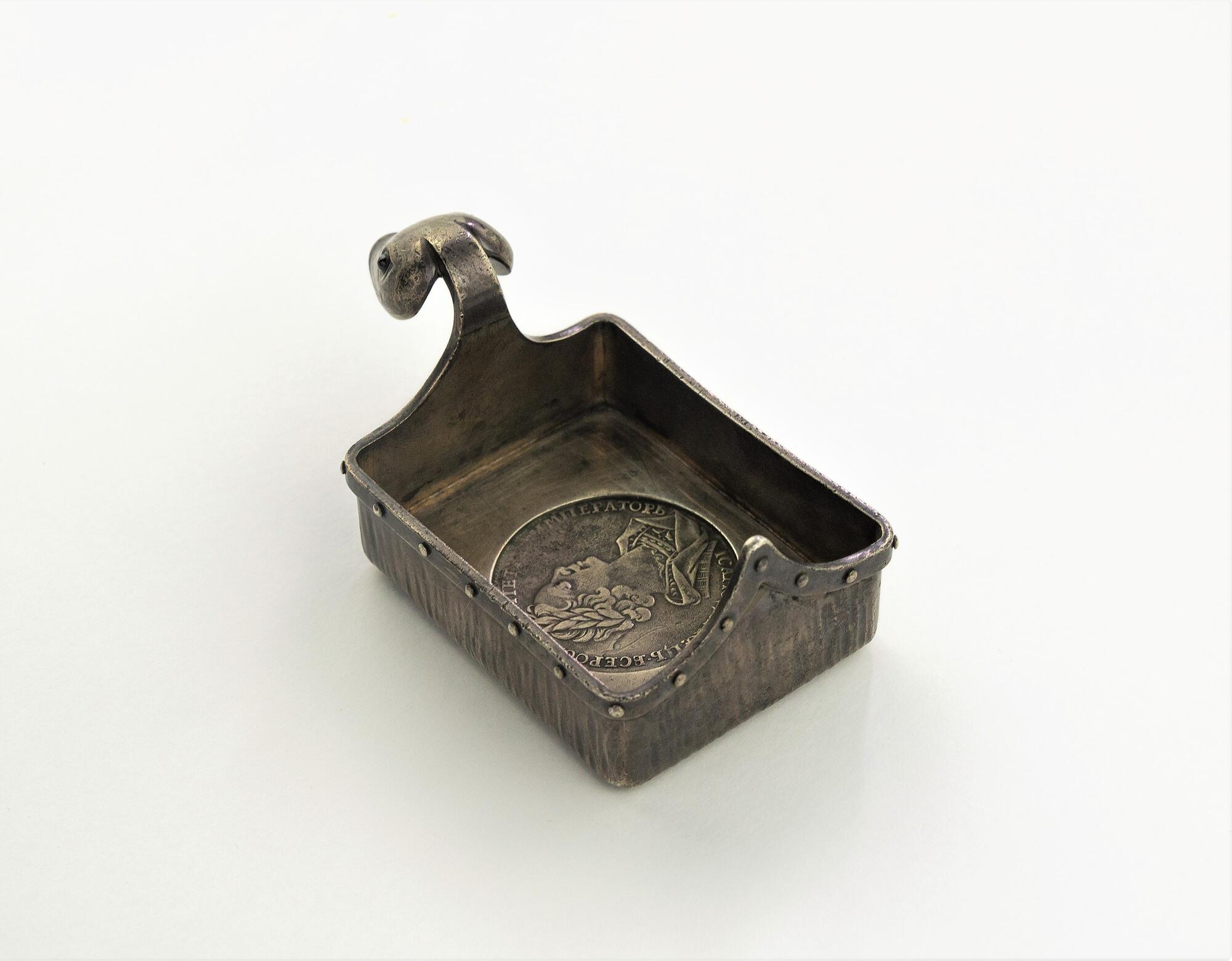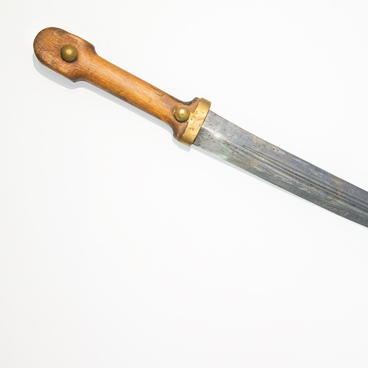The silver kovsh was made in the workshop of the House of Fabergé — a jewelry firm founded in Russia in 1842. It became well-known because of the famous Easter eggs, which the masters created at the request of the emperor’s family.
The decorated kovsh dates back to the 19th century. It looks like a traditional medieval Russian ware — bratina. The head of the duck embellishing the item is decorated with garnet inserts. The perimeter of the kovsh has a rim attached with rivets.
A silver coin of the times of Peter the Great, a 1725 ruble, is inserted into the bottom of the kovsh. Such coins appeared as a result of the monetary reform, which the tsar carried out after he returned from the long journey across Europe. In 1700, copper coins in denominations of half a kopeck (denga), a quarter of a kopeck (polushka), and one-eighth of a kopeck (polupolushka) appeared in Russia. The issue of such coins was to facilitate small-scale retailing.
The population was informed about these novelties beforehand. The issued decree highlighted that new copper money was as legal as the silver kopecks.
Next year, the new Kadashevsky mint opened, where silver coins in denominations of 50 (poltina), 25 (polupoltinnik), 10 (grivennik), and five (ten dengas) kopecks were issued. New silver rubles and copper kopecks appeared in 1704.
During the reign of Peter the Great, a ruble coin entered circulation and became the basis of the monetary system. All estimations began to be carried out in rubles, not in kopecks. The appearance of the coin was constantly changing. For example, there were more than 13 variants of a ruble with portraits of Peter the Great.
The first Russian emperor in ancient armor is depicted on the coin soldered in the bottom of the museum’s kovsh. The inscription is coined around the portrait: ‘The Emperor and Autocrat of All the Russias, Peter.’ On the reverse in the centre, the monogram in the form of a cross from four letters ‘П’ (Cyrillic ‘P’) with crowns above is depicted. Around the circle is the inscription: ‘The new coin, price of a ruble’.
The museum purchased this sample from N. Sinyukova in 1967. A year before, she gave the museum a 1723 ruble, also with a portrait of Peter the Great.
The decorated kovsh dates back to the 19th century. It looks like a traditional medieval Russian ware — bratina. The head of the duck embellishing the item is decorated with garnet inserts. The perimeter of the kovsh has a rim attached with rivets.
A silver coin of the times of Peter the Great, a 1725 ruble, is inserted into the bottom of the kovsh. Such coins appeared as a result of the monetary reform, which the tsar carried out after he returned from the long journey across Europe. In 1700, copper coins in denominations of half a kopeck (denga), a quarter of a kopeck (polushka), and one-eighth of a kopeck (polupolushka) appeared in Russia. The issue of such coins was to facilitate small-scale retailing.
The population was informed about these novelties beforehand. The issued decree highlighted that new copper money was as legal as the silver kopecks.
Next year, the new Kadashevsky mint opened, where silver coins in denominations of 50 (poltina), 25 (polupoltinnik), 10 (grivennik), and five (ten dengas) kopecks were issued. New silver rubles and copper kopecks appeared in 1704.
During the reign of Peter the Great, a ruble coin entered circulation and became the basis of the monetary system. All estimations began to be carried out in rubles, not in kopecks. The appearance of the coin was constantly changing. For example, there were more than 13 variants of a ruble with portraits of Peter the Great.
The first Russian emperor in ancient armor is depicted on the coin soldered in the bottom of the museum’s kovsh. The inscription is coined around the portrait: ‘The Emperor and Autocrat of All the Russias, Peter.’ On the reverse in the centre, the monogram in the form of a cross from four letters ‘П’ (Cyrillic ‘P’) with crowns above is depicted. Around the circle is the inscription: ‘The new coin, price of a ruble’.
The museum purchased this sample from N. Sinyukova in 1967. A year before, she gave the museum a 1723 ruble, also with a portrait of Peter the Great.



